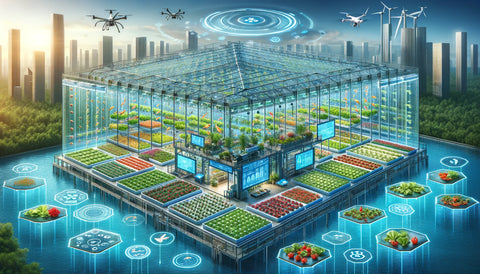The Benefits of Aquaponics
Aquaponics system: Fish and Plants in Harmony
Aquaponics system
Learning Aquaponics: fish and plants
An outline:
Learning Aquaponics' Fish-Plant Benefits
Aquaponics System Preparation
Fish Selection for Aquaponics
Selecting Aquaponics Plants
Keeping Aquaponics Water Quality Good Aquaponic Nutrient Control
Common Aquaponics Issues
Get and Enjoy Aquaponics Results
The Future of Aquaculture
Learning Aquaponics
Aquaponics is a sustainable and environmentally friendly farming system that combines fish farming and hydroponics. Fish feces feed plants, which purify fish water. You must understand these factors to succeed in aquaponics:
Fish supply plant nutrients, therefore picking the proper species is important. Aquaponics uses trout, catfish, and tilapia. Maintaining ecological balance requires considering fish species' nutritional outputs, growth rates, and temperature needs.
Plants: Aquaponics systems often grow lettuce, basil, mint, tomatoes, and peppers. Building the system requires considering each plant's nutritional demands, development patterns, and harvest cycles.
Plants receive nitrates from beneficial microorganisms that transform fish waste, or ammonia. For fish and plant growth, water quality depends on the nitrogen cycle.
Water Quality: Fish and plants need pH, ammonia, nitrite, and nitrate levels monitored. Consistent testing and alterations foster optimal growth.
Aquaponics systems can be small domestic or huge commercial. This adaptability offers numerous doors. Ecosystem structure, water flow, aeration, and filtration must be addressed for effectiveness.
Mastering these characteristics can help humans create a sustainable aquaponics system. This creates a closed-loop nutrient exchange cycle for food production by allowing fish and plants to coexist.
Plants and Fish Benefit Each Other
A sustained fish-plant environment is created via aquaponics.
Fish excrement feeds plants, which filter water and provide a healthy fish habitat in this closed-loop system.
Beneficial bacteria turn fish waste, ammonia, into nitrates, which plants may use for nitrogen.
Plants filter fish water by absorbing nitrates.
Fish and plants have a mutually beneficial cycle due to this dependency.
Aquaponics uses photosynthesis and the nitrogen cycle to save water and fertilizer.
Save resources and the environment with this sustainable fish and vegetable production system.
The symbiotic link between fish and plants in aquaponics teaches ecological concepts and species connectivity.
Aquaponics demonstrates how fish and plants coexist. Fish and plants interdepend.

Aquaponics System Preparation
An aquaponics system requires multiple processes to integrate fish and plants in a harmonic ecosystem:
Good Place Selection Choose a spot with a stable temperature and adequate sunshine for plant development for healthy fish.
Choose aquaponic-friendly fish like tilapia, trout, and goldfish and water-absorbing plants like lettuce, herbs, and tomatoes.
Building a fish tank involves space for fish to swim and a filtration system to maintain water quality.
Installation: Mount the grow bed on the fish tank. This enables grow bed water flow by gravity. Add gravel or expanded clay pellets to the grow bed.
Pipes deliver water from the fish tank to the grow bed. This filters fish water and feeds plants.
To keep fish and plants healthy, water pH and ammonia levels should be monitored routinely.
Give your fish a balanced diet and check their health to avoid systemic concerns.
A successful aquaponics system that benefits both sides of this mutually beneficial connection requires following these principles and caring for the fish and plants.
Fish Selection for Aquaponics
Your aquaponics system's performance depends on numerous criteria when choosing fish. Note these crucial points:
Fish species should fit your aquaponics system's surroundings. Trout want colder water, although tilapia like water.
Local aquaponics fish-keeping restrictions should be considered. For environmental or conservation grounds, several regions ban certain fish.
Your aquaponics system size determines the fish you can maintain. Goldfish may prefer smaller systems, whereas catfish prefer larger ones.
Consider your target fish's diet. Tilapia is an omnivore, although other fish have dietary demands.
Check the fish's growth rate before purchase. Fast-growing fish like tilapia can mature and be caught quickly.
Fish species tolerate pH, oxygen, and ammonia differently. Fish species require different water quality. Choose fish for aquaponics.
Consider these parameters and choose the proper species for your aquaponics system to establish a sustainable fish and plant environment.
Selecting Aquaponics Plants
Selecting aquaponics plants involves careful consideration of numerous criteria. This maximizes plant potential and ecological balance. Choose the best aquaponics plants using these tips:
Some plants flourish at certain water temperatures. Consider the water temperature demands of your plants.
Select plants with comparable pH and nutrient demands to facilitate upkeep. This configuration simplifies aquaponics balancing.
Leafy greens like lettuce, kale, basil, and mint thrive in aquaponics. These aquaponic plants are popular with home gardens.
Avoid feeding or nutrient-intensive plants in small-scale aquaponics. Avoid such plants since they need loads of fertilizer. Choose nutrient-absorbing plants for air wellness.
Space and light are essential. To thrive, tomatoes and cucumbers require more space and sunlight. Aquaponics systems should provide the correct atmosphere for plants.
Aquaponics lets you experiment with different plants. Test different species to see which ones flourish in your environment.
You may establish a balanced aquaponics system for fish and plants by examining these qualities and choosing plants wisely.
Maintaining Aquaponics Water Quality
Fish and plants depend on aquaponics water quality. Tips for good water quality:
Water pH should be checked routinely to safeguard fish and plants. The ideal pH is 6.8–7.0.
Ammonia from fish waste pollutes water and harms ecosystems. Ammonia must be controlled. A biological filter converts ammonia into plant-friendly nitrites and nitrates.
Provide oxygen: Fish and vegetation thrive on oxygen. Aerate the water using air stones or other methods, especially in hot weather when oxygen levels decline.
Monitor water temperature for fish and plants. Keep your species' water temperature right to avoid stress.
To keep ammonia, nitrites, nitrates, and other contaminants low, test water periodically. This lets you discover and solve problems early.
Clean the Filters and Remove Debris: Regular filter cleaning prevents obstruction and purifies water. Additionally, this prevents water contamination.
Fish excrement from overfeeding degrades water quality. Only feed fish what they can eat rapidly to reduce waste.
Following these criteria and monitoring water quality regularly will help you construct a successful aquaponics system for fish and plants.
Aquaponic Nutrient Control
Aquaponics need the correct nutrients to keep fish and plants healthy. Key nutritional control guidelines:
Checking water parameters Regular water testing maintains fish and plant-friendly pH, ammonia, nitrite, and nitrate levels.
Fish require nutrients. Overfeeding fish can upset the water's natural equilibrium by oversupplying food and minerals. Give fish only what they can consume fast.
Fish waste and uneaten food from overstocked aquaponics systems can cause nutritional imbalances. Fish stocking needs caution.
Add Beneficial Bacteria: Bacteria nitrify fish waste for plants. This keeps the nitrogen cycle healthy.
Grown plants require more nutrients, so feed and harvest accordingly. Adjust your fish's feeding rates to feed plants adequately.
Periodically clean filters, inspect piping, and remove debris to prevent nutrient accumulation. Nutritional levels need constant management.
Give Supplements: Dietary deficits may need iron or potassium supplementation.
By following these guidelines and monitoring nutrient levels, you can succeed with aquaponics. This will allow fish and plants coexist and benefit.
Common Aquaponics Issues
Low pH
Use different pH solutions to test and alter pH. Maintain pH between 6.8 and 7.2 if possible.
Ammonia levels high
Aerate the system to produce nitrites and nitrates from ammonia. Maintain water filtration and circulation.
Poor plant growth
Check and adjust nutrition. Give plants ample light and fertilize if needed.
Concerns regarding Fish Health
Always monitor fish density and water quality. Act soon if fish appear stressed or sick.
Grow Bed Clog
Clean up the grow bed to improve water flow. A filter can avoid obstruction.
Overgrowth of algae
Light may be reduced by covering the grow bed or tank. Use algae-eating fish or physically remove algae.
Failure of Pump
Regularly inspect the pump. Always have an emergency pump.
Alterations in temperature
Maintaining fish and plant temperatures requires insulation. Heat or cool as required.
Insufficient nutrition
Check the plant for nutritional deficits like yellowing leaves or poor growth. Adjust diet and add calcium or iron.
Addressing common difficulties early and efficiently can help aquaponicists maintain fish and plants healthy.
Get and Enjoy Aquaponics Results
Aquaponics yields lots of fish and plants, making it economical. Optimize your aquaponics system with these tips:
Plant Gathering: Select your aquaponics plants at their peak. The outer leaves of kale and lettuce can be removed while the inner leaves develop. Trim basil and mint periodically for fresh growth. Just give the plant enough leaves to grow.
Fish harvesting is aquaponics' highlight. Choose edible fish like tilapia or trout. Fish should fast for 24–48 hours before harvesting to cleanse their digestive tracts. Aquaponics beginners should question more experienced growers about animal-friendly harvesting.
Aquaponics is lovely because it yields edible fruits. Knowing they're additive-free lets you enjoy fresh salad greens. The taste of your garden herbs may bring great delight. Enjoy presenting fresh, sustainable fish to loved ones.
Enjoy the natural cycle of aquaponics and the connection between the fish, plants, and you, the caretaker. As you care for your body, enjoy the many fruits it produces and remember that you are part of a healthy ecosystem that feeds you and the environment.

The Future of Aquaculture
Aquaponics is projected to continue its meteoric ascent because to its environmental friendliness and resource efficiency.
Technological advances are expected to make aquaponics systems more accessible to more people.
Researchers are exploring new aquaponics methods to promote fish and plant health.
Aquaponics in urban agriculture can improve food security and self-sufficiency.
Aquaponics can produce chemical-free fruits and vegetables, which is becoming more significant as organic product demand rises.
Aquaponics enthusiasts, scientists, and politicians must collaborate to expand this cutting-edge agricultural method.
Future aquaponics development might revolutionize agriculture and promote sustainable food production.





Leave a comment